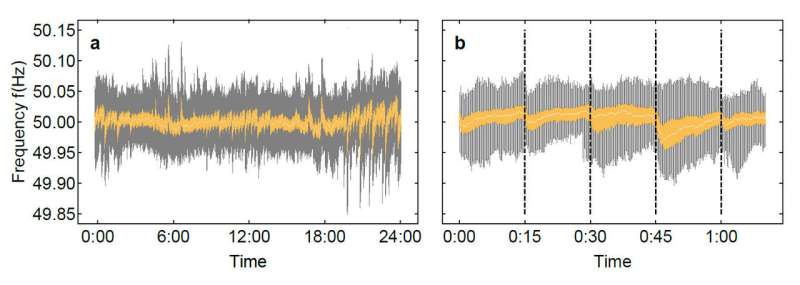Diverse causes behind frequency fluctuations in power grids

The use of renewables like the sun and wind can cause fluctuations in power grids. But what impact do these fluctuations have on security of supply? To answer this question, scientists from Juelich and Goettingen worked together with colleagues in London and Tokyo to analyse different types of fluctuations in several power grids in Europe, Japan, and the U.S., and came to surprising conclusions. Their study was published today in the peer-reviewed journal Nature Energy.
Our power grid works at a frequency of 50 hertz. Most power is generated by turbines in hydro- or coal power plants, which rotate at a speed of 50 revolutions per second. "When a consumer uses more electrical energy from the power grid, the grid frequency drops slightly before an increased energy feed-in re-establishes the original frequency," explains Benjamin Schaefer from the Max Planck Institute for Dynamics and Self-Organization (MPIDS) in Goettingen and lead author of the study. "Deviations from the nominal value of 50 hertz must be kept to a minimum, as otherwise sensitive electrical devices could be damaged."
Renewable energy generation also causes grid frequency fluctuations because the wind does not always blow at the same speed and clouds constantly alter the feed-in from photovoltaic systems. A frequent suggestion for integrating renewable energy generators into the power grid involves breaking the grid down into small autonomous cells known as microgrids. This would allow a community with a combined heat and power unit and its own wind and photovoltaic generators, for example, to operate its energy systems in an autonomous manner.
But what impact would this division into small cells and additional renewable generators have on the power grid? To answer this question, scientists from Forschungszentrum Juelich and MPIDS analysed the grid frequency fluctuations in power grids in different regions of the world. Using mathematical models, they predicted potential vulnerabilities and their causes.
First, they collated measurements from Europe, Japan, and the U.S. Then they systematically analysed the data and were surprised on two accounts. "The first surprise was that the grid showed particularly strong fluctuations every 15 minutes," says Dirk Witthaut from Juelich's Institute of Energy and Climate Research und the Institute for Theoretical Physics of the University of Cologne. "This is the exact time frame during which generators on the European electricity market agree on a new distribution for the electricity generated—this alters how much electricity is fed into the grid, and where. In Europe, at least, power trading therefore plays a key role in balancing grid frequency fluctuations."
The second surprise was that statistical grid fluctuations around the nominal value of 50 hertz do not follow the expected Gaussian distribution, which is a symmetrical distribution around an expected value. Instead, more extreme fluctuations are probable. Using mathematical models, the scientists calculated the expected fluctuations depending on the grid size and estimated the degree to which the fluctuations depended on renewables.
Power trading as a key factor
A comparison of the investigated regions showed that a large proportion of renewables did, indeed, lead to greater grid fluctuations. "For example, the share of wind and solar generation in the United Kingdom is much higher than in the U.S., leading to greater fluctuations in grid frequency," explains Dirk Witthaut. For an increased share of renewables, the scientists therefore recommend increased investment in an intelligent adjustment of generator and consumer according to the grid frequency—known as primary control and demand control.
One of the most interesting findings of the study, however, is that grid frequency fluctuation caused by power trading appeared to be more significant than fluctuation caused by renewable feed-in.
The scientists also discovered that small power grids show larger fluctuations. "Our study indicates that dividing large and thus very slow grids—such as the synchronous grid of Continental Europe—into microgrids will cause larger frequency fluctuations," says Benjamin Schaefer. "Technically, microgrids are therefore only an option if today's very stringent frequency standards were to be relaxed."
More information: Benjamin Schäfer et al, Non-Gaussian power grid frequency fluctuations characterized by Lévy-stable laws and superstatistics, Nature Energy (2017). DOI: 10.1038/s41560-017-0058-z
Journal information: Nature Energy
Provided by Forschungszentrum Juelich





















